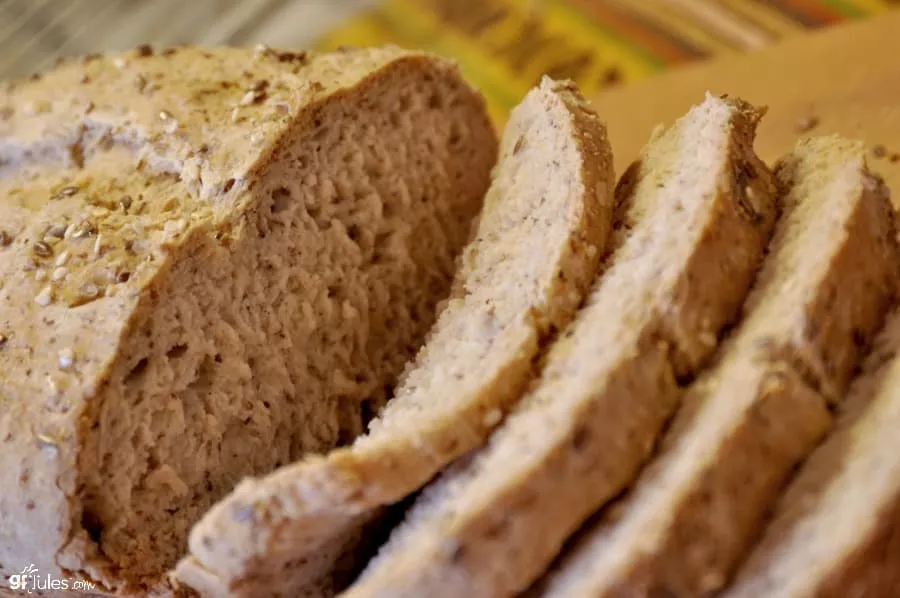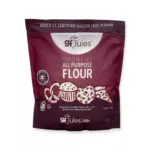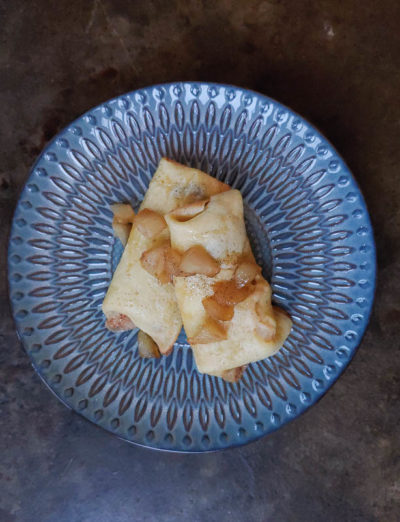Everyone wants great bread … sometime. So don’t let being gluten free stop you from enjoying a sandwich because you bought dry, hard gluten-free bread at the store and think that’s your only option. Soft, fresh, scrumptious gluten-free sandwich bread is not a pipe-dream. It’s easy when you make it yourself with this recipe.

That’s because this crowd-favorite recipe for gluten-free Sandwich Bread has been making people happy for years. I’m happy to share it with you, too, because everyone deserves great bread.
With the right gluten free ingredients and this simple gluten-free Sandwich Bread recipe OR my even easier, award-winning gfJules® Gluten Free Bread Mix, anyone can whip up a loaf of great gluten free bread or dinner rolls in under 2 hours. I’ll show you how!

What are the Options for Making Gluten-Free Sandwich Bread?
With this recipe, you can use a bread maker OR bake in the oven. It’s best not to use a hand mixer, but instead to use a stand mixer or a large food processor with a dough blade, as this dough when made with yogurt is very thick (if using another liquid, the dough is more batter-like); alternatively, you could stir the recipe with a wooden spoon in a large bowl.
No pan is even necessary; if you don’t have a loaf pan, simply follow the directions to make a gluten free artisan loaf on a baking sheet!

If you’d like to add more fiber to this bread recipe, remove 1/2 cup of my gfJules Flour and substitute with 1/2 cup of a higher fiber certified gluten free flour (try millet, sorghum, almond, buckwheat or teff). My gfJules Flour should provide enough support and structure without making the bread too heavy. The loaf will take on the flavor of whatever other grain you’ve added.
Want higher protein? Use a high protein milk/mylk as the liquid you add.

If you want to make homemade Gluten Free Cinnamon-Raisin Bread – hop to my recipe here.
This awesome recipe produces a loaf you can slice as thick or as thin as you like, and it may be made nearly allergy-free! I’ve given you tons of ingredient options to make this bread just the way you like it and your whole family can enjoy it safely. Gluten-free, dairy-free, soy-free, nut-free … and it will stay moist for days (if it lasts in your house that long!). Pass the recipe along to anyone you know with other food restrictions and share the wealth!
If you want to bake fresh bread with even fewer steps, use my easy, #1 voted gfJules® Gluten-Free Bread Mix, and you won’t be disappointed! It turns out a beautiful artisan loaf with a nice crunchy crust, from the oven or bread machine!

And if you somehow have any slices left over after a few days, make the most delicious gluten free French Toast around! Slice them thick or thin, dredge in egg, milk, and a dash of cinnamon, then fry in a little butter … mmmmmm. It’s the best breakfast around! (and so easy!). It also makes a great gluten-free French Toast Casserole!
And lastly, if you’re searching for a different style of gluten free dinner rolls, you simply MUST try my gluten free Pull-Apart Dinner Rolls! They’re pillowy soft and never fail to please even the pickiest bread eaters!

Search my Homemade Gluten Free Breads tab for all kinds of gluten free bread recipes — from yeast-free to artisan, brown bread to boules … they’re all there!

Gluten Free Sandwich Bread and Dinner Rolls Recipe
Ingredients
- 1 gfJules Gluten Free Bread Mix
OR
Dry Ingredients:**
- 3 (405) cups (grams) gfJules® All-Purpose Gluten-Free Flour
- 1/4 (26) cup (grams) flax seed meal (or gfJules Gluten Free Multigrain Baking Flour)
- 1/4 cup dry milk powder dairy or non-dairy (e.g. Coconut Milk Powder) {OR gluten free vanilla pudding mix OR protein powder}
- 1/2 tsp. baking soda
- 2 tsp. baking powder
- 1 tsp. sea salt
PLUS these Liquid Ingredients:
- 2 Tbs. honey OR agave nectar date syrup OR coconut palm nectar
- 1 1/4 cup room temperature liquid: EITHER sparkling water club soda, ginger ale or gluten free beer, milk of choice (not skim), OR plain yogurt*
- 1 tsp. apple cider vinegar
- 1/4 cup extra virgin olive oil
- 2 large eggs (or 2 Tbs. flax seed meal steeped for 10 minutes in 6 Tbs. hot water) or other egg substitute like aquafaba
PLUS
- 1 Tbs. rapid rise or bread machine yeast gluten-free (Red Star Quick Rise®)
Toppings (optional):
- 1 Tbs. flaxseeds or sesame seeds, herbs, certified GF purity protocol oats, etc. (optional)
- 1 Tbs. coarse sea salt (optional)
Instructions
- Oven Directions:**(See notes if using gfJules Gluten Free Bread Mix)
- Whisk these dry ingredients together in a large bowl: GF flours, milk powder, baking soda, baking powder and salt.
- In the large mixing bowl of a stand mixer, stir together the wet ingredients: honey, liquid of choice (sparkling water/club soda/gingerale/milk/yogurt etc.), apple cider vinegar, oil and egg/flax seed and water mixture. Gradually add the dry ingredient mix in with the wet by pouring slowly into the wet bowl while mixing with the paddle attachment. Once incorporated, add the yeast granules and beat well for 1 - 2 more minutes.
- If using yogurt, the dough will be very thick (much more like regular wheat flour bread dough than you may be used to with gluten free); however, if the dough seems too thick to spread into a loaf pan, gradually mix in milk, one tablespoon at a time, until the dough is still thick, but able to be smoothed with a spatula. If using another liquid, the dough will be more batter-like and easier to pour into the pan.
- Scoop the dough into an oiled bread pan (use a dark metal pan if you like a darker crust on your bread; lighter, shiny metal or glass if you like a light crust). The pan should be at least 8.5 x 4.5 inches; 9 x 5 or Pullman pans work well.
- Smooth the top, sprinkle with any toppings, then cover with a damp towel or a sheet of wax paper sprayed with cooking oil. Sit the covered dough for at least 30 minutes in a warm place like an oven warming drawer or an oven preheated to 200º F then turned off.
- Remove the cover from the raised dough and transfer to a preheated convection oven set to 325º F or a preheated static oven set to 350º F. Cook for approximately 60 minutes, or until the crust is browning nicely and a cake tester or skewer inserted into the center of the loaf comes out clean (internal temperature should reach 205-210º F). Remove to a cooling rack. When cooled for 15 minutes, gently remove from the loaf pan to finish cooling before slicing

Gluten Free Dinner Roll Directions:
- Prepare muffin tins or popover trays by oiling. Scoop equal amounts into each tray and smooth the tops. Sprinkle desired toppings. Cover and rise as directed above.
- Bake at 350º F convection or 375º F static for 15 minutes, or until the crust is browning nicely and a toothpick inserted into the center of the rolls comes out clean (internal temperature should reach 205-210º F). Depending on how big the rolls are (muffin tin versus popover size), they may take a bit longer to cook, but test often to be sure they don't over-cook. Remove to a cooling rack.

Gluten Free Bread Machine Directions:
- Baking bread in a breadmaker is simple. There are 3 steps: liquids first; then dry ingredients; then yeast. Read more tips on bread machines and gluten free breads in my article on using bread machines.
- Bring all liquids to room temperature before adding to the machine, if possible. Whisk together the yolks and whites before adding to the bread machine with the other liquids; alternatively, allow the flax seed meal to steep in water for 10 minutes before adding. Whisk together dry ingredients and add on top of liquids in the pan. Make a small well with your finger in the center of the dry ingredients and pour in the yeast.

- Select either the gluten-free bread setting on your machine, or the setting with only one rise cycle and no punch-down (2 lb loaf setting). Close the lid to the bread machine and let it do the rest!
- When the machine is done mixing, smooth the top with a rubber spatula and sprinkle any desired toppings on top of the loaf. Close lid again to bake.
- Once the bake cycle is complete, test the temperature of the interior of the loaf before removing from the pan with a bread baking thermometer – it should have reached at least 205º F. If it hasn’t yet reached that temperature, either add time to your bread machine as another bake cycle of 5-10 minutes, or simply put the pan into a regular oven at 350º F (static), testing the temperature again at five minute intervals.

Notes
** Please keep in mind that nutrition information provided is per serving, which may vary. While we have taken care to provide you with the most accurate nutritional values possible, please note that this information may differ significantly depending on the exact ingredients and brands that you choose to use to make this recipe. Additionally, where options are given for ingredients, the resulting calculation may include all ingredient options instead of only one per line, skewing the totals significantly.
I hope you love this easy gluten free sandwich bread recipe!
Pin for later!













































Can I use red star active dry yeast that I already have as opposed to rapid dry yeast?
Hi Donna, you can absolutely use the active dry yeast, you’ll just need to proof it first. You can follow the instructions in this post on how to do that.
~jules
I really love this bread mix! Delicious and easy! Could the bread mix also be used as a straight substitute for “white bread flour” in non-GF bread machine recipes, cup-for-cup?
So glad to hear you’re loving my gfJules Bread Mix! I just pulled a loaf out of the oven, myself! There’s nothing like fresh, homemade bread!!!
If you’re looking to sub for non-GF bread recipes, you could certainly try using my bread mix, measured out, or my Multigrain GF Flour, which is based on the same bread mix, but without the extra leaveners and salt that are in the bread mix itself. Just make sure to use a bread machine setting with only one rise and mixing cycle. Check out my bread machine reviews post for more info on how to test your bread machine cycles to be sure they’ll work well for gluten free breads!
~jules
I would love to use your GF flour, but I get migraines, and while it’s unusual, there are those of us whose migraines are triggered by, among other things, tapioca. Do you/will you have a tapioca-free GF bread mix, or can you recommend one? Or a recipe that doesn’t use tapioca flour/starch? A more common trigger is millet flour, so for those who have migraines, that must be avoided as well.
Thanks in advance for any advice!
Hi Inga, I suffer from migraines as well, but I guess lucky for me that tapioca isn’t a trigger. You can check out my gluten free flour comparison article for information on how to make your own base flour mixture so you can still use my recipes with flour alternatives that suit your dietary needs. I hope that helps!
~jules
Thank you so very much! I’m sorry you get them too.
I’m glad you’ve identified a way to avoid yours!!
~jules
Hi, can you tell me what the difference is in the finished product between regular gluten-free bread and bread machine gluten-free bread? Are they identical in taste, texture, etc?
Hi Kristi – check out this article where I reviewed several top gluten free bread machines. I used my gfJules Gluten Free Bread Mix to make the breads for all the bake-outs and you can see the texture and rise for them; the size and crust on the loaves will differ, but the taste is the same between the oven and the bread machine. I hope that helps!
~jules
Jules, what is the best way slice this bread and get even, thin slices? I am doing it free handed and it is anything but even or thin. Thanks
Hi Kathryn, there are a couple different kinds of bread guide/knife options if you’re interested in very uniform slices. I, too, like very thin slices, but I’m not as much of a stickler for uniformity! Here’s one with a guide and knife all in one and another that’s a bread holder with slicing guides. These seem to be the most popular options. I hope one of these helps!
~jules
No Pan Sandwich Bread – I decided to make this “loaf” without a pan. I used GFJules All-purpose flour, Holidaily IPA as the liquid, and added 2 Tbl of protein powder. The loaf turned bread turned out beautifully, full of flavor “with a hint of the IPA”, fluffy and moist!!
Mmmmmmm I can almost smell it from here, John! That looks fabulous!!!!!!! Thanks so much for sharing your yummy photo – you’re putting me in the mood for homemade bread now, for sure!
~jules
Of the gf flours I’ve tried, Jules is my favorite for sure. I like that I can use the same flour for 1:1 substitutions and for your sandwich bread. I think it’s the best flavored bread I’ve made.
I have been freezing it half a loaf at a time but have trouble with the slices falling apart very easily when I thaw them. Any recommendations to keep this from happening? Thanks!
Hi Mary Beth – I’m so happy you’re loving my gfJules Flour! There are two suggestions I have regarding freezing the loaf: one is to slice the loaf before freezing and put parchment or wax paper between the slices so it’s easier to separate when taking out of the freezer; secondly, if you still have troubles, definitely try using my gfJules Bread Mix instead of making from scratch. The bread mix is different from the from scratch recipes, as it’s made with other ingredients which should help it to hold together even better and stay fresher even longer. I’d love to hear how it goes after you give those two a try!
~jules
Question: I just made the GF Bread and followed the directions (used milk) and the dough was extremely thick. I know the directions say that if you use yogurt it will be thicker but this dough I made with milk was super super thick and not a batter consistency. Is this normal? I had to oil a spatula to spread the dough in the bread pan the best I can. I place it in the oven to rise and it looks somewhat decent. It’s still in the oven baking. I was just curious if anyone else had this issue with the dough being so think while using milk.
Hi Sabrina, it’s still a bread dough, so it should be thicker than a batter, so you should be good to go, assuming you used all the other ingredients as listed and measured properly. Fingers crossed!!!
~jules
Love this recipe! It is my go-to 😁 I know I have read it somewhere on your site, but I cannot find it. If I wish to freeze the dough, at which point do I do that? Thank you
Glad to hear you love this recipe, Jennifer! As for freezing gluten free bread dough, I recommend freezing it before rising, then bringing it out and allowing it to come to room temp, then rising You can see more thorough instructions in this gluten free cinnamon rolls recipe. Enjoy!
~jules
Love all your recipes! Can you double this and make two loafs in one go???
So glad you’re loving my recipes, Julie!!! If you have a large enough mixer you certainly can. It makes a lot of dough, so just make sure your mixer and bowl can handle that.
~jules
Hi Jules! I just discovered your site and am excited to learn from you about gf bread baking. Do you have any truly “from scratch” regular (sandwich) bread recipes? Thought I’d ask before I rifle through more recipes. Thanks!
Hi Karin, so happy you found me! This gluten free sandwich bread recipe is a great place to start, as there is a “from scratch” base recipe to work from. My gluten free “beer” bread recipe is another great one to try, or gluten free cinnamon-raisin bread, too! So many great ones to play with! Focaccia, artisan bread, baguettes — so fun!
~jules
I followed the directions to the letter. Even went out to purchase some items I did not have in the cupboard. It looked good but did not even raise a tiny bit. I am afraid I will just get a large lump of dense dough for all my trouble. Deeply disappointed as I purchase the flour regularly and it is expensive to waste.
Hi Judy, have you baked the loaf off already and it just didn’t rise before baking? Did it smell yeasty at all? I wonder if the batch of yeast was not good? It’s always a possibility, although it doesn’t happen often. If you have any of the same yeast lot left over you can test it and see if it’s still viable by adding some to warm water and a little sugar to see if there’s activity.
If the yeast is good and the dough didn’t rise, then you look to other things instead, like measuring issues. Have you read this article on measuring dry ingredients for gluten free baking yet?
In terms of the ingredients you added, what milk dry milk powder did you use and what liquid did you add?
~jules
Is it possible to use liquid milk instead of powdered milk and take out the equivalent of the water that you would add?
Hi Kaye, I see where you’re going with the question, and I love your thought process! If the dry milk was just there as a milk powder alone, that would work, but it’s there for structure, so the effect won’t quite be the same. You could certainly do that, but if you experience any sinking in the bread after cooling, you’ll probably want to go back to the original recipe as written with the dry milk powder instead. Have you given my award-winning gfJules Bread Mix a try yet? It contains all the ingredients necessary for a perfect loaf without having to run around trying to find extraneous ingredients!
~jules
Hi Jules, I made this bread using the bread mix with Gosling regular ginger ale and honey. We loved it! However, my daughter is reluctant to have me make it again because it crumbled up in her school lunch. Is there a better combination of alternate ingredients (other than ginger ale and honey) which would give a more resilient texture? Or a better technique? I mixed the batter ina kitchen aid mixer and let it rise in an oiled bread pan only once as you instruct, then baked it. I will admit, it smelled so good, we cut into it before it was fully cool – did that possibly affect the texture? Thank you
Hi Debbie, I’m so happy that you all loved the bread mix made with ginger ale and honey! It is tempting to slice into it quickly because the smell of fresh baked bread is so heavenly!!!
To make it slightly more resilient for school lunches you could bake it with milk instead of ginger ale and/or you could lightly toast the slices before making them into sandwiches just to keep them from crumbling in transit. My favorite for school lunches is actually to use the bread mix to make homemade gluten-free bagels because they transport so well and the bagels are just amazing! Have you tried that recipe yet? Does your daughter like bagels? You can make the bagels any flavor and also any size you like, so that’s also another option for you! You can reserve the bread mix + ginger ale option for the bread you make and slice and eat at home that way!
~jules
Yeast- I already have active dry yeast at home. Is rather it not go to waste. Is there a way to use this rather than instant in baking bread loaf in the oven? I’ll be making from scratch using milk powder, eggs, and club soda for one loaf and then a 2nd with no eggs but egg replacer.
Hi Sara, you can absolutely do that. You’ll just want to proof the yeast first. Check out the method in this article on yeast if you’re unfamiliar with it, and also add some extra rise time.
Enjoy!
~jules
How do I make this with flours I already own? I don’t want to have purchase yet another A-P GF flours.
I hear you on the “I already have too many gluten free flours in my cabinet” part!!! That’s why I created my gfJules Blend because I was so fed up with buying all those different flours for all those different recipes. This ONE flour does it all better than any other combo I’ve ever tried, so I never have to deal with that headache and expense again!
Check out this article on gluten free flours to see what you have on hand and compare to what’s in my blend and see if you think it might work for this recipe. The problem is that all gluten free flours are SO VERY DIFFERENT!! I can’t say if it would work at all, but take a look at the article and see what you think!
~jules
Hi Jules, I have made the bread many times, both with your bread mix and from scratch with your flour. Always in my bread machine and measuring all the ingredients accurately. I find that I have to add at least another 1/4 cup of liquid because the dough is too dry. Maybe the extra liquid is the reason my bread doesn’t rise enough and is always a bit dense (or maybe it’s the Canadian air that isn’t compatible). Do I need to add more yeast or baking powder? Any suggestions are welcome. Dense or not, we love the taste of your bread and eat it anyway.
I made the bread twice exactly by the recipe. Both times by the time we had eaten while warm the bread was already stale tasting. What am I doing wrong?
Hi Yvonne, that’s very odd indeed!! Were you using my gfJules Gluten Free Bread Mix or baking from scratch?
~jules
From scratch.